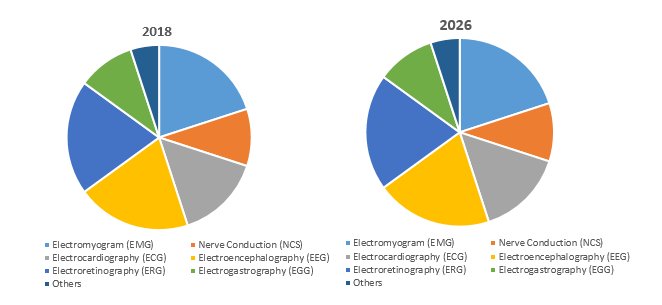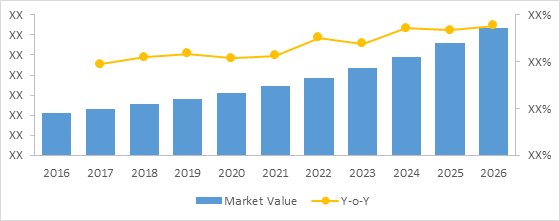Electro-Diagnostic Devices Market – Insights
Electro-diagnostic devices are used to diagnose the neurological diseases by recording the electrical activity of body parts or by measuring their response to evoked potentials. The medical professionals use electrophysiological techniques such as needle electromyography and nerve conduction studies to diagnose, evaluate, and treat individuals with impairments of the neurologic, neuromuscular, and/or muscular systems.
The global electro-diagnostic devices market size was valued at US$ 970.6 million in 2017, and is expected to witness a CAGR of 7.50% over the forecast period (2018 – 2026).
Global Electro-Diagnostic Devices Market Share (%) Analysis, by Product Type, 2018 and 2026

To learn more about this report, Download Free Sample
Source: Coherent Market Insights Analysis (2018)
Increasing Prevalence of Neuromuscular Diseases such as Amyotrophic lateral sclerosis (ALS), Multiple sclerosis, and Muscular dystrophy is Expected to Drive the Electro-Diagnostic Devices Market Revenue
Rising prevalence of neuromuscular diseases such as Amyotrophic Lateral Sclerosis (ALS), multiple sclerosis, and muscular dystrophy is propelling demand for electro-diagnosis, which in turn is driving growth of the electro-diagnostic devices market. For instance, according to the Cleveland Clinic Foundation, 2016, multiple sclerosis affects around 2.5 million people worldwide. Early symptoms of multiple sclerosis majorly occur in age group of 20-50 years.
Growing geriatric population worldwide is increasing the risk of neuromuscular disorders, which is also a major factor driving the electro-diagnostic devices market growth. For instance, as per the report published by United Nations in 2017, the number of older people in age group 60 years or over is projected to reach from 962 million in 2017, to 2.1 billion in 2050 globally. Furthermore, according to the U.S. Census Bureau’s 2017, National Population Projections, an estimated 78.0 million people will be around age 65 years and older as compared to 76.7 million under the age of 18 in U.S by 2035.
Electro-Diagnostic Devices Market Restraints
Although demand for electro-diagnostic devices is increasing worldwide, there is a lack of skilled labors in low-income countries such as India. Unfavorable labor laws and limited trained workforce in India to install operate, repair, and service equipment is restraining growth of the electro-diagnostic devices market.
Moreover, high installation and maintenance costs of these complex devices is one of the major factor hampering growth of the market. For instance, the high cost of EEG system, which is nearly US$ 1,13,616 and high cost of maintenance limits its widespread use in for Epilepsy Monitoring Units (EMUs) across the globe, especially in developing economies where the funding or reimbursements for these devices is inadequate.
Electro-Diagnostic Devices Market - Regional Insights
On the basis of region, the global electro-diagnostic devices market is segmented into North America, Latin America, Europe, Asia Pacific, Middle East, and Africa. In 2026, North America is expected to hold the leading position in the global electro-diagnostic devices market, owing to well-established healthcare infrastructure, higher adoption rate for technologically advanced products by the healthcare providers and growing awareness regarding advanced medical devices are major factors driving growth of the electro-diagnostic devices market. Moreover, high prevalence of neurological diseases area fueling growth of the market. For instance, according to National Centers for Biotechnology Information (NCBI), multiple sclerosis affects around 1 million individuals in the U.S. in 2016.
Asia Pacific electro-diagnostic devices market is expected to grow at the highest rate due to high patient pool in the region. Increasing healthcare expenditure will act as a driver for growth of medical sector in countries such as India. Continuous developments and rising demand for better electro-diagnostics device in the region are expected to boost the electro-diagnostic devices market growth in near future.
Global Electro-Diagnostic Devices Market Value (US$ Mn) & Y-o-Y Growth (%)

To learn more about this report, Download Free Sample
Source: Coherent Market Insights Analysis (2018)
Electro-Diagnostic Devices Market - Competitive Landscape
Key players operating in the global electro-diagnostic devices market include Medtronic, Abbott, Boston Scientific Corporation, Siemens Medical Solutions, Philips Medical Systems, GE Healthcare, Noraxen, Viasys Healthcare, Natus Medical, Cadwell Laboratories Inc, Compumedics Limited, and Nihon Kohden. Manufacturers in electro-diagnostic devices market are focused on expanding their business in emerging economies, which offers untapped growth opportunities for growth of the electro-diagnostic devices market.
Share
Share
Missing comfort of reading report in your local language? Find your preferred language :
Transform your Strategy with Exclusive Trending Reports :
Frequently Asked Questions
Select a License Type
Joining thousands of companies around the world committed to making the Excellent Business Solutions.
View All Our Clients